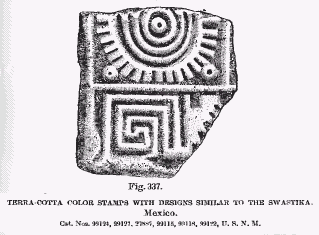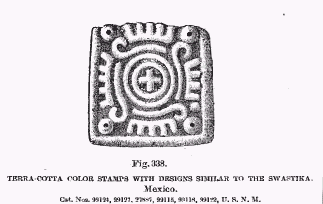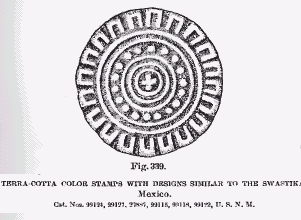

The Swastika
The Cross Among The American Indians
Color Stamps From Mexico and Venezuela.
The aborigines of Mexico and Central and South America employed terra-cotta color stamps, which, being made into the proper pattern in the soft clay, were
 burned
hard; then, being first coated with color, the stamp was pressed upon
the object to be decorated, and so transferred its color, as in the mechanical
operation of printing, thus giving the intended decoration. Patterns of
these stamps are inserted in this paper in connection with the Swastika
because of the resemblance --- not in form, but in style. They are of
geometric form, crosses, dots, circles (concentric and otherwise), lozenges,
chevrons, fret, and labyrinth or meander. The style of this decoration
lends itself easily to the Swastika; and yet, with the variety of patterns
contained in the series of stamps belonging to the U. S. National Museum,
shown in figs. 337, 338, 339, 340,
341 and 342,
no Swastika appears; nor in the similar stamps belonging to other collections,
notably that of Mr. A. E. Douglass, in the Metropolitan Museum of Natural
burned
hard; then, being first coated with color, the stamp was pressed upon
the object to be decorated, and so transferred its color, as in the mechanical
operation of printing, thus giving the intended decoration. Patterns of
these stamps are inserted in this paper in connection with the Swastika
because of the resemblance --- not in form, but in style. They are of
geometric form, crosses, dots, circles (concentric and otherwise), lozenges,
chevrons, fret, and labyrinth or meander. The style of this decoration
lends itself easily to the Swastika; and yet, with the variety of patterns
contained in the series of stamps belonging to the U. S. National Museum,
shown in figs. 337, 338, 339, 340,
341 and 342,
no Swastika appears; nor in the similar stamps belonging to other collections,
notably that of Mr. A. E. Douglass, in the Metropolitan Museum of Natural
 History,
Central Park, New York, are any Swastikas shown. Of the foregoing figures,
all are form Tlaltelolco, Mexico (Blake collection), except fig. 339,
which is form the Valley of Mexico, and was received from the Museo Nacional
of Mexico.
History,
Central Park, New York, are any Swastikas shown. Of the foregoing figures,
all are form Tlaltelolco, Mexico (Blake collection), except fig. 339,
which is form the Valley of Mexico, and was received from the Museo Nacional
of Mexico. Marcano says: (1)
The present Pinroas of Venezuela are in the habit of painting their bodies by a process different from that of the North American Indian. They make stamps of wood, which, being colored (as types are with ink), they apply to their bodies. Fig. 982 shows examples of these stamps. [See fig. 343 of the present paper.] The designs are substantially the same as some petroglyphs. They either copied the
 models
they found carved on the rocks by peoples who preceded them, or they knew
the meaning and preserved the tradition. The former is the only tenable
hypothesis. Painting to the Piaroas both ornamentation and necessity.
It serves, not only as a garment to protect them against insects, but
become a fancy costume to grace their feasts and meetings.
models
they found carved on the rocks by peoples who preceded them, or they knew
the meaning and preserved the tradition. The former is the only tenable
hypothesis. Painting to the Piaroas both ornamentation and necessity.
It serves, not only as a garment to protect them against insects, but
become a fancy costume to grace their feasts and meetings.These designs are not presented as Swastikas nor of any evolution or derivation form one. They show a style common enough to Central and South America, to the Antilles and the Canary Islands, (2) which might easily produce a Swastika. The aboriginal designer of these might, if we depend upon the theory of psychological similarity of culture among all peoples, at this next attempt make a Swastika. Yet, with the hundreds of similar patterns made during the centuries of aboriginal occupation and extending throughout the countries named, none of these seem ever to have produced a Swastika.
ENDNOTES:
1. Mem. Soc. d'Anthrop., Paris, 1890, p. 200. [Back]
2. De Quatrefages, "Histoire Généreale du Races Humaines," Introduction, p. 239, figs. 185-191, 193-194. Back
<< Previous Page Next Page >>
© 2004-2007 Northvegr.
Most of the material on this site is in the public domain. However, many people have worked very hard to bring these texts to you so if you do use the work, we would appreciate it if you could give credit to both the Northvegr site and to the individuals who worked to bring you these texts. A small number of texts are copyrighted and cannot be used without the author's permission. Any text that is copyrighted will have a clear notation of such on the main index page for that text. Inquiries can be sent to info@northvegr.org. Northvegr™ and the Northvegr symbol are trademarks and service marks of the Northvegr Foundation.

|